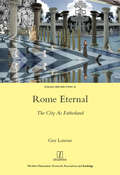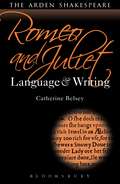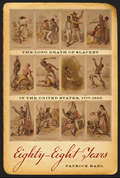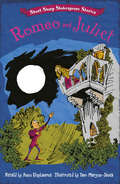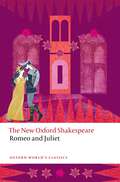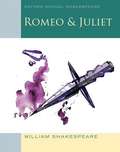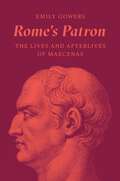- Table View
- List View
Rome Against Caratacus: The Roman Campaigns in Britain AD 48-58
by Graham WebsterThe Roman Conquest of Britain in AD 43 was one of the most important turning points in the history of the British Isles. It left a legacy still discernible today in the form of archaeological remain, road networks, land divisions and even language.In his much-acclaimed trilogy, now up-dated and revised, Dr Webster builds up a fascinating and lively picture of Britain in the first century AD and discussed in detail the various types of evidence and the theories based upon it.Caratacus' last stand against the Romans has a central place in the folklore of the Welsh Marches, where many a hill is claimed to be the site of the famous battle. But, as Graham Webster shows, this epic encounter was not only real history but also part of an intricate ten-year series of campaigns conducted after the initial conquest of Britain.By interpreting the ancient historical accounts and piecing together the masses of archaeological evidence, Dr Webster has brilliantly reconstructed this central period of the Claudian Conquest of Britain and its immediate aftermath.
Rome Eternal: The City as Fatherland
by Guy LanoueWhat does 'Roman' mean? How does the mythical city touch people's identities, values and attitudes? In the long-established and official imaginary of the West, Rome is the citta dell'arte, the city of faith, an heirloom city inspired by the traces of ancient Empire, by the brooding aura of the Church, by Hollywood fairy-tale romance, and by the spicy tang of veiled decadence. But what of its contemporary residents? Are they now merely guides and waiters servicing throngs of tourists indifferent to the city's contemporary charms? Guy Lanoue, a former resident of Rome, explores how Romans live the modern myth of Rome Eternal. Since the 19th century, it has defined an important community, the fatherland, a home-spun society where the rules of everyday life become 'tradition': ways of eating, dressing, making and keeping friends and acquaintances, 'proper' ways of speaking and a hard to define but nonetheless tangible air of composure. Guy Lanoue is a Professor of Anthropology at the Universite de Montreal.
Rome Eternal: The City as Fatherland
by Guy LanoueWhat does 'Roman' mean? How does the mythical city touch people's identities, values and attitudes? In the long-established and official imaginary of the West, Rome is the citta dell'arte, the city of faith, an heirloom city inspired by the traces of ancient Empire, by the brooding aura of the Church, by Hollywood fairy-tale romance, and by the spicy tang of veiled decadence. But what of its contemporary residents? Are they now merely guides and waiters servicing throngs of tourists indifferent to the city's contemporary charms? Guy Lanoue, a former resident of Rome, explores how Romans live the modern myth of Rome Eternal. Since the 19th century, it has defined an important community, the fatherland, a home-spun society where the rules of everyday life become 'tradition': ways of eating, dressing, making and keeping friends and acquaintances, 'proper' ways of speaking and a hard to define but nonetheless tangible air of composure. Guy Lanoue is a Professor of Anthropology at the Universite de Montreal.
Rome, Postmodern Narratives of a Cityscape (Warwick Series in the Humanities)
by Dom HoldawayUntil the mid-twentieth century the Western imagination seemed intent on viewing Rome purely in terms of its classical past or as a stop on the Grand Tour. This collection of essays looks at Rome from a postmodern perspective, including analysis of the city's 'unmappability', its fragmented narratives and its iconic status in literature and film.
Rome, Postmodern Narratives of a Cityscape (Warwick Series in the Humanities #2)
by Dom HoldawayUntil the mid-twentieth century the Western imagination seemed intent on viewing Rome purely in terms of its classical past or as a stop on the Grand Tour. This collection of essays looks at Rome from a postmodern perspective, including analysis of the city's 'unmappability', its fragmented narratives and its iconic status in literature and film.
Rome, Season One: History Makes Television
by Monica Silveira CyrinoRome, Season One: History Makes Television examines the first season of the HBO-BBC collaboration, Rome, in a collection of thought-provoking essays by some of the world’s most influential scholars in the fields of classical antiquity and popular culture. Examines the first season of the HBO-BBC collaboration, Rome, in a collection of 17 thought-provoking essays by some of the world’s most influential scholars in the fields of classical antiquity and popular culture Focuses on the award-winning first season’s historical framework, visual and narrative style, contemporary thematic overtones, and influence on popular culture Addresses the artistic values, and roles of the script, sets, and actors Reveals how the series Rome ‘makes history’ in terms of representing the past on screen and producing innovative and influential television.
Rome Victorious: The Irresistible Rise of the Roman Empire (Library of Classical Studies)
by Dexter HoyosRome – Urbs Roma: city of patricians and plebeians, emperors and gladiators, slaves and concubines – was the epicentre of a far-flung imperium whose cultural legacy is incalculable. How a tiny settlement, founded by desperate adventurers beside the banks of the River Tiber, came to rule vast tracts of territory across the face of the known world is one of the more improbable stories of antiquity. The epic scale of the Colosseum; majestically columned temples; formidable legionaries marching in burnished steel breastplates; and capricious Caesars clad in purple robes who thought themselves gods: all these images speak of a grandeur that continues to be associated with this most celebrated of ancient capitals. The glory of Rome is further underlined by enduring monuments like Hadrian's Wall, holding the line as it did against ferocious Pictish barbarians thought to be from Hyperborea: the mythic Land Beyond the North Wind. This book vividly recounts the rags-to-riches story of Rome's unlikely triumph.Perhaps the most famous example in history of modest beginnings rising to greatness, Rome's empire was never static or uniform. Over the centuries, under the 'boundless grandeur of the Roman peace' (as the Elder Pliny put it), imperial law, civilisation and language vigorously interacted with and influenced local cultures across western and central Europe and North Africa. Provincial subjects were made Roman citizens, generals and senators. In AD 98 Trajan became the first of many Romans from outside Italy to assume supreme power as Emperor. Poets, philosophers, historians and legalists – and many others besides – all participated in the brilliant intellectual constellation secured by the pax Romana. However, as Dexter Hoyos reveals, the empire was not won cheaply or fast, and did not always succeed. The Carthaginian general Hannibal came close to destroying it. Arminius freed Germania by brutally annihilating three irreplaceable legions in the Teutoburg Forest – a disaster that broke Augustus' heart. And the Romans themselves, in expanding their empire, were often ruthless. Caesar boasted of killing a million enemy fighters in his Gallic Wars, while the accusation of a Caledonian lord became proverbial: they make a desert and call it peace. Yet at the same time the Romans strove to impose moral and legal principles for directing their subjects as much as themselves, and laid down standards of government that are still valid today. Rome Victorious is a masterful new treatment of the rise of Rome – from the viewpoints both of the city itself and the people it came to rule and make its own.
Rome Victorious: The Irresistible Rise of the Roman Empire (Library of Classical Studies)
by Dexter HoyosRome – Urbs Roma: city of patricians and plebeians, emperors and gladiators, slaves and concubines – was the epicentre of a far-flung imperium whose cultural legacy is incalculable. How a tiny settlement, founded by desperate adventurers beside the banks of the River Tiber, came to rule vast tracts of territory across the face of the known world is one of the more improbable stories of antiquity. The epic scale of the Colosseum; majestically columned temples; formidable legionaries marching in burnished steel breastplates; and capricious Caesars clad in purple robes who thought themselves gods: all these images speak of a grandeur that continues to be associated with this most celebrated of ancient capitals. The glory of Rome is further underlined by enduring monuments like Hadrian's Wall, holding the line as it did against ferocious Pictish barbarians thought to be from Hyperborea: the mythic Land Beyond the North Wind. This book vividly recounts the rags-to-riches story of Rome's unlikely triumph.Perhaps the most famous example in history of modest beginnings rising to greatness, Rome's empire was never static or uniform. Over the centuries, under the 'boundless grandeur of the Roman peace' (as the Elder Pliny put it), imperial law, civilisation and language vigorously interacted with and influenced local cultures across western and central Europe and North Africa. Provincial subjects were made Roman citizens, generals and senators. In AD 98 Trajan became the first of many Romans from outside Italy to assume supreme power as Emperor. Poets, philosophers, historians and legalists – and many others besides – all participated in the brilliant intellectual constellation secured by the pax Romana. However, as Dexter Hoyos reveals, the empire was not won cheaply or fast, and did not always succeed. The Carthaginian general Hannibal came close to destroying it. Arminius freed Germania by brutally annihilating three irreplaceable legions in the Teutoburg Forest – a disaster that broke Augustus' heart. And the Romans themselves, in expanding their empire, were often ruthless. Caesar boasted of killing a million enemy fighters in his Gallic Wars, while the accusation of a Caledonian lord became proverbial: they make a desert and call it peace. Yet at the same time the Romans strove to impose moral and legal principles for directing their subjects as much as themselves, and laid down standards of government that are still valid today. Rome Victorious is a masterful new treatment of the rise of Rome – from the viewpoints both of the city itself and the people it came to rule and make its own.
Romeo and Juliet: Critical Essays (Shakespearean Criticism)
by John F. AndrewsOriginally published in 1993. Presenting excerpts and articles on the themes and characters from the most famous story of young lovers, this collection brings together scholarship relating to the language, performance, and impact of the play. Ordered in three parts, the chapters cover analysis, reviews and interpretation from a wide ranging array of sources, from the play’s contemporary commenters to literary critics of the early 1990’s. The volume ends with an article by the editor on the action in the text which concludes the final section of 8 pieces looking at the story as being a product of Elizabethan Culture. It considers the attitude to the friar, to morality and suicide, the stars and fate, and gender differences. Comparisons are made to Shakespeare’s source as well as to productions performed long after the Bard’s death.
Romeo and Juliet: Language and Writing (Arden Student Skills: Language and Writing)
by Catherine BelseyArden Student Skills: Language and Writing offer a new type of study aid which combines lively critical insight with practical guidance on the critical writing skills you need to develop in order to engage fully with Shakespeare's texts. The books' core focus is on language: both understanding and enjoying Shakespeare's complex dramatic language, and expanding your own critical vocabulary, as you respond to his plays. Key features include: • an introduction considering when and how the play was written, addressing the language with which Shakespeare created his work, as well as the generic, literary and theatrical conventions at his disposal • detailed examination and analysis of the individual text, focusing on its literary, technical and historical intricacies • discussion of performance history and the critical reception of the work • a 'Writing matters' section in every chapter, clearly linking the analysis of Shakespeare's language to your own writing strategies in coursework and examinations Written by world-class academics with both scholarly insight and outstanding teaching skills, each guide will empower you to read and write about Shakespeare with increased confidence and enthusiasm. How to find something new to say about this most familiar of Shakespeare's plays? Catherine Besley shows you how to build your understanding by starting with a focus on key speeches before looking at Shakespeare's sources and showing how his use of them can inform a critical appreciation of the play. She goes on to examine the exquisite poetry in the play and to unpick its complex rhetoric as well as examining key productions and adaptations such as the classic Baz Lurhmann film.
Romeo and Juliet: Language and Writing (Arden Student Skills: Language and Writing #5)
by Catherine BelseyArden Student Skills: Language and Writing offer a new type of study aid which combines lively critical insight with practical guidance on the critical writing skills you need to develop in order to engage fully with Shakespeare's texts. The books' core focus is on language: both understanding and enjoying Shakespeare's complex dramatic language, and expanding your own critical vocabulary, as you respond to his plays. Key features include: • an introduction considering when and how the play was written, addressing the language with which Shakespeare created his work, as well as the generic, literary and theatrical conventions at his disposal • detailed examination and analysis of the individual text, focusing on its literary, technical and historical intricacies • discussion of performance history and the critical reception of the work • a 'Writing matters' section in every chapter, clearly linking the analysis of Shakespeare's language to your own writing strategies in coursework and examinations Written by world-class academics with both scholarly insight and outstanding teaching skills, each guide will empower you to read and write about Shakespeare with increased confidence and enthusiasm. How to find something new to say about this most familiar of Shakespeare's plays? Catherine Besley shows you how to build your understanding by starting with a focus on key speeches before looking at Shakespeare's sources and showing how his use of them can inform a critical appreciation of the play. She goes on to examine the exquisite poetry in the play and to unpick its complex rhetoric as well as examining key productions and adaptations such as the classic Baz Lurhmann film.
Romeo and Juliet: Romeo And Juliet (Short, Sharp Shakespeare Stories #3)
by Anna ClaybourneTwo families at war, and a pair of young, star-crossed lovers caught in the crossfire... Discover the tragic story at the heart of Romeo and Juliet, Shakespeare's most famous play. The age-appropriate text in Short, Sharp Shakespeare Stories: Romeo and Juliet introduces readers to the play by re-telling the story in modern English, making it an ideal introduction to Shakespeare for children of 9 and above. The book also contains information about the background to Romeo and Juliet, its major themes, language, and Shakespeare's life during the time he was writing the play, so is a useful resource for project work, or for anyone studying the play itself.Poisons, and their application in 16th century England, are also examined, to give the play a factual grounding.Anna Claybourne's concise, witty text really brings out the humour and the drama of the stories, rendering them as relevant today as they were in Shakespeare's time. Comparisons with themes in modern life: love, revenge, family relationships, political power struggles, etc., serve to reinforce this.The text is supported by Tom Morgan-Jones' fantastic artwork, giving the series real visual appeal. Short, Sharp Shakespeare Stories allow children today to be as enthralled by Shakespeare's tales as audiences were 400 years ago. Other titles in the series include Macbeth, A Midsummer Night's Dream, The Tempest, Much Ado About Nothing and Hamlet.
Romeo and Juliet: A Critical Reader (Arden Early Modern Drama Guides)
by Julia Reinhard LuptonUniquely, this guide analyses the play's critical and performance history and recent criticism, as well as including five essays offering radically new paths for contemporary interpretation. The subject matter of these essays is rich and diverse, ranging across the play's philosophical identification of sexual love with self-realization, the hermeneutic implications of an editor's textual choices, the minor characters of the play in relation to Renaissance performance traditions, Romeo and Juliet in opera and ballet, and the play's Italian sources and afterlives. The guide also contains a chapter on the key resources available, including scholarly editions and easily available DVDs, and discusses the ways in which they can be used in the classroom to aid understanding and provoke further debate. Edited by leading scholar Julia Reinhard Lupton, this is an essential guide for both students and scholars of Shakespeare.
Romeo and Juliet: A Critical Reader (Arden Early Modern Drama Guides)
by Julia Reinhard LuptonUniquely, this guide analyses the play's critical and performance history and recent criticism, as well as including five essays offering radically new paths for contemporary interpretation. The subject matter of these essays is rich and diverse, ranging across the play's philosophical identification of sexual love with self-realization, the hermeneutic implications of an editor's textual choices, the minor characters of the play in relation to Renaissance performance traditions, Romeo and Juliet in opera and ballet, and the play's Italian sources and afterlives. The guide also contains a chapter on the key resources available, including scholarly editions and easily available DVDs, and discusses the ways in which they can be used in the classroom to aid understanding and provoke further debate. Edited by leading scholar Julia Reinhard Lupton, this is an essential guide for both students and scholars of Shakespeare.
Romeo and Juliet: York Notes for GCSE (9-1) (PDF)
by John Polley Jo HeathcoteA fully revised exam section: expert guidance on understanding the question, planning an answer, writing about effects and using quotations, plus tips on spelling, punctuation and grammar. All the key skills covered: 'Exam focus' model answer extracts with annotations, and 'Progress and Revision Checks' will guide students' learning, help them test their progress and reach their potential. The most in-depth analysis: from text summaries to characters, themes, contexts, form, structure and language, all designed to help students reach their potential.
Romeo and Juliet: Critical Essays (Shakespearean Criticism)
by Romeo JulietOriginally published in 1993. Presenting excerpts and articles on the themes and characters from the most famous story of young lovers, this collection brings together scholarship relating to the language, performance, and impact of the play. Ordered in three parts, the chapters cover analysis, reviews and interpretation from a wide ranging array of sources, from the play’s contemporary commenters to literary critics of the early 1990’s. The volume ends with an article by the editor on the action in the text which concludes the final section of 8 pieces looking at the story as being a product of Elizabethan Culture. It considers the attitude to the friar, to morality and suicide, the stars and fate, and gender differences. Comparisons are made to Shakespeare’s source as well as to productions performed long after the Bard’s death.
Romeo and Juliet: The New Oxford Shakespeare (Oxford World's Classics)
by William Shakespeare'A pair of star-crossed lovers take their life' This edition provides a clear and accessible introduction to Shakespeare's enduring tale of ill-fated lovers. Hannah August pays particular attention to the dramatic function of the famous prologue and the significance of the play's ending. August also explores ways of reading the play as a text that queries rather than validates the tenets of heterosexual romantic love, proving that at multiple points throughout the play's four-hundred-years-plus stage history, Verona has been more queer than the prevailing view of Romeo and Juliet as a core text of heterosexual love might lead us to believe. It includes a substantial section which addresses the play's early modern production and reception history in both print and performance, as well as providing an overview of later performance traditions drawing on up-to-date examples of key productions. The New Oxford Shakespeare offers authoritative editions of Shakespeare's works with introductory materials designed to encourage new interpretations of the plays and poems. Using the text from the landmark The New Oxford Shakespeare Complete Works: Modern Critical Edition, these volumes offer readers the latest thinking on the authentic texts (collated from all surviving original versions of Shakespeare's work) alongside innovative introductions from leading scholars. The texts are accompanied by a comprehensive set of critical apparatus to give readers the best resources to help understand and enjoy Shakespeare's work. ABOUT THE SERIES: For over 100 years Oxford World's Classics has made available the widest range of literature from around the globe. Each affordable volume reflects Oxford's commitment to scholarship, providing the most accurate text plus a wealth of other valuable features, including expert introductions by leading authorities, helpful notes to clarify the text, up-to-date bibliographies for further study, and much more.
Romeo and Juliet: The New Oxford Shakespeare (Oxford World's Classics)
by William Shakespeare'A pair of star-crossed lovers take their life' This edition provides a clear and accessible introduction to Shakespeare's enduring tale of ill-fated lovers. Hannah August pays particular attention to the dramatic function of the famous prologue and the significance of the play's ending. August also explores ways of reading the play as a text that queries rather than validates the tenets of heterosexual romantic love, proving that at multiple points throughout the play's four-hundred-years-plus stage history, Verona has been more queer than the prevailing view of Romeo and Juliet as a core text of heterosexual love might lead us to believe. It includes a substantial section which addresses the play's early modern production and reception history in both print and performance, as well as providing an overview of later performance traditions drawing on up-to-date examples of key productions. The New Oxford Shakespeare offers authoritative editions of Shakespeare's works with introductory materials designed to encourage new interpretations of the plays and poems. Using the text from the landmark The New Oxford Shakespeare Complete Works: Modern Critical Edition, these volumes offer readers the latest thinking on the authentic texts (collated from all surviving original versions of Shakespeare's work) alongside innovative introductions from leading scholars. The texts are accompanied by a comprehensive set of critical apparatus to give readers the best resources to help understand and enjoy Shakespeare's work. ABOUT THE SERIES: For over 100 years Oxford World's Classics has made available the widest range of literature from around the globe. Each affordable volume reflects Oxford's commitment to scholarship, providing the most accurate text plus a wealth of other valuable features, including expert introductions by leading authorities, helpful notes to clarify the text, up-to-date bibliographies for further study, and much more.
Romeo And Juliet (Oxford School Shakespeare Series (28pt PDF) )
by William Shakespeare Roma GillOxford School Shakespeare is an acclaimed edition especially designed for students, with accessible on-page notes and explanatory illustrations, clear background information, and rigorous but accessible scholarly credentials. This edition of Romeo and Juliet includes illustrations, preliminary notes, reading lists (including websites) and classroom notes. Romeo and Juliet is a set text for KS3 in England, and remains one of the most popular texts for study by secondary students the world over. This title is suitable for all exam boards and for the most recent GCSE specifications.
Romeo and Juliet, Adaptation and the Arts: 'Cut Him Out in Little Stars' (Shakespeare and Adaptation)
by Mark Thornton BurnettRomeo and Juliet is the most produced, translated and re-mixed of all of Shakespeare's plays. This volume takes up the iconographic, linguistic and performance layers already at work within it and tracks the play's dispersal into neighbouring art forms – including ballet, opera, television and architecture – and geographical locations, including Italy, Ireland, France, India and Korea.Chapters trace Shakespeare's own acts of adaptation and appropriation of sources and the play's subsequent migrations into other media. Part One considers reworkings of Romeo and Juliet in Hector Berlioz's 1839 choral symphony and ballets choreographed by Sir Kenneth MacMillan and John Neumeier. Part Two explores the afterlives of Shakespeare's lovers in the narrative forms of fiction, film and serial television, including works by James Joyce, Samuel Beckett and HBO's series Westworld.Part Three examines dramatic adaptations of the play into other languages, dialects and cultural contexts. Authors consider Hindi translations and the complex and changing status of Shakespeare's work in India, as well as productions of the play in Korea set against its evolving history. The volume ends with a first-person account of staging Romeo and Juliet at an HBCU (historically Black college/university), documenting the tensions between the notion of Shakespeare as a universal author and the lived experiences of marginalized communities as they engage with his plays.
Romeo and Juliet, Adaptation and the Arts: 'Cut Him Out in Little Stars' (Shakespeare and Adaptation)
by Mark Thornton BurnettRomeo and Juliet is the most produced, translated and re-mixed of all of Shakespeare's plays. This volume takes up the iconographic, linguistic and performance layers already at work within it and tracks the play's dispersal into neighbouring art forms – including ballet, opera, television and architecture – and geographical locations, including Italy, Ireland, France, India and Korea.Chapters trace Shakespeare's own acts of adaptation and appropriation of sources and the play's subsequent migrations into other media. Part One considers reworkings of Romeo and Juliet in Hector Berlioz's 1839 choral symphony and ballets choreographed by Sir Kenneth MacMillan and John Neumeier. Part Two explores the afterlives of Shakespeare's lovers in the narrative forms of fiction, film and serial television, including works by James Joyce, Samuel Beckett and HBO's series Westworld.Part Three examines dramatic adaptations of the play into other languages, dialects and cultural contexts. Authors consider Hindi translations and the complex and changing status of Shakespeare's work in India, as well as productions of the play in Korea set against its evolving history. The volume ends with a first-person account of staging Romeo and Juliet at an HBCU (historically Black college/university), documenting the tensions between the notion of Shakespeare as a universal author and the lived experiences of marginalized communities as they engage with his plays.
Rome's Christian Empress: Galla Placidia Rules at the Twilight of the Empire
by Joyce E. SalisburyIn Rome’s Christian Empress, Joyce E. Salisbury brings the captivating story of Rome’s Christian empress to life. The daughter of Roman emperor Theodosius I, Galla Placidia lived at the center of imperial Roman power during the first half of the fifth century. Taken hostage after the fall of Rome to the Goths, she was married to the king and, upon his death, to a Roman general. The rare woman who traveled throughout Italy, Gaul, and Spain, she eventually returned to Rome, where her young son was crowned as the emperor of the western Roman provinces. Placidia served as his regent, ruling the Roman Empire and the provinces for twenty years.Salisbury restores this influential, too-often forgotten woman to the center stage of this crucial period. Describing Galla Placidia’s life from childhood to death while detailing the political and military developments that influenced herâ€�and that she influenced in turnâ€�the book relies on religious and political sources to weave together a narrative that combines social, cultural, political, and theological history. The Roman world changed dramatically during Placidia’s rule: the Empire became Christian, barbarian tribes settled throughout the West, and Rome began its unmistakable decline. But during her long reign, Placidia wielded formidable power. She fended off violent invaders and usurpers who challenged her Theodosian dynasty; presided over the dawn of the Catholic Church as theological controversies split the faithful and church practices and holidays were established; and spent fortunes building churches and mosaics that incorporated prominent images of herself and her family. Compulsively readable, Rome’s Christian Empress is the first full-length work to give this fascinating and complex ruler her due.
Rome's Patron: The Lives and Afterlives of Maecenas
by Emily GowersThe story of Maecenas and his role in the evolution and continuing legacy of ancient Roman poetry and cultureAn unelected statesman with exceptional powers, a patron of the arts and a luxury-loving friend of the emperor Augustus: Maecenas was one of the most prominent and distinctive personalities of ancient Rome. Yet the traces he left behind are unreliable and tantalizingly scarce. Rather than attempting a conventional biography, Emily Gowers shows in Rome’s Patron that it is possible to tell a different story, one about Maecenas’s influence, his changing identities and the many narratives attached to him across two millennia.Rome’s Patron explores Maecenas’s appearances in the central works of Augustan poetry written in his name—Virgil’s Georgics, Horace’s Odes and Propertius’s elegies—and in later works of Latin literature that reassess his influence. For the Roman poets he supported, Maecenas was a mascot of cultural flexibility and innovation, a pioneer of gender fluidity and a bearer of imperial demands who could be exposed as a secret sympathizer with their own values. For those excluded from his circle, he represented either favouritism and indulgence or the lost ideal of a patron in perfect collaboration with the authors he championed.As Gowers shows, Maecenas had and continues to have a unique cachet—in the fantasies that still surround the gardens, buildings and objects so tenuously associated with him; in literature, from Ariosto and Ben Johnson to Phillis Wheatley and W. B. Yeats; and in philanthropy, where his name has been surprisingly adaptable to more democratic forms of patronage.
Rome's Patron: The Lives and Afterlives of Maecenas
by Emily GowersThe story of Maecenas and his role in the evolution and continuing legacy of ancient Roman poetry and cultureAn unelected statesman with exceptional powers, a patron of the arts and a luxury-loving friend of the emperor Augustus: Maecenas was one of the most prominent and distinctive personalities of ancient Rome. Yet the traces he left behind are unreliable and tantalizingly scarce. Rather than attempting a conventional biography, Emily Gowers shows in Rome’s Patron that it is possible to tell a different story, one about Maecenas’s influence, his changing identities and the many narratives attached to him across two millennia.Rome’s Patron explores Maecenas’s appearances in the central works of Augustan poetry written in his name—Virgil’s Georgics, Horace’s Odes and Propertius’s elegies—and in later works of Latin literature that reassess his influence. For the Roman poets he supported, Maecenas was a mascot of cultural flexibility and innovation, a pioneer of gender fluidity and a bearer of imperial demands who could be exposed as a secret sympathizer with their own values. For those excluded from his circle, he represented either favouritism and indulgence or the lost ideal of a patron in perfect collaboration with the authors he championed.As Gowers shows, Maecenas had and continues to have a unique cachet—in the fantasies that still surround the gardens, buildings and objects so tenuously associated with him; in literature, from Ariosto and Ben Johnson to Phillis Wheatley and W. B. Yeats; and in philanthropy, where his name has been surprisingly adaptable to more democratic forms of patronage.
Roms Aufstieg zur Weltmacht: Das Zeitalter der Punischen Kriege
by Gunnar ManzDieser Band widmet sich einem der wichtigsten Abschnitte der römischen Geschichte, dem Zeitalter der Punischen Kriege. In diesem erbittert geführten Konflikt konnte sich Rom gegen seinen größten Konkurrenten im westlichen Mittelmeer durchsetzen und dabei den Grundstein für seinen weiteren Aufstieg zur Weltmacht legen. Karthago indes verschwand 146 v.Chr. von der Weltkarte. Beginnend mit den ersten vertraglichen Beziehungen zwischen Rom und Karthago bis hin zur endgültigen Zerstörung der punischen Metropole 146 v.Chr. wird die römisch-karthagische Geschichte unter Berücksichtigung quellenkritischer Analysen und der wesentlichen Forschungskontroversen ausführlich dargestellt. Somit liegt erstmals wieder eine Gesamtdarstellung dieses spannenden Zeitabschnitts der römischen Geschichte vor, die sich einerseits an Forschung und Lehre richtet, zugleich aber auch für den geschichtsinteressierten Leser verständlich bleibt.

